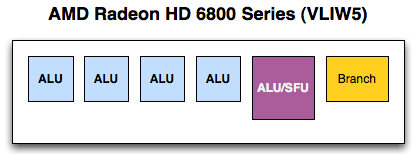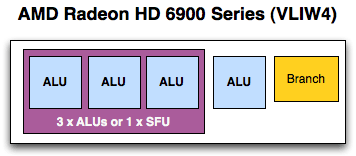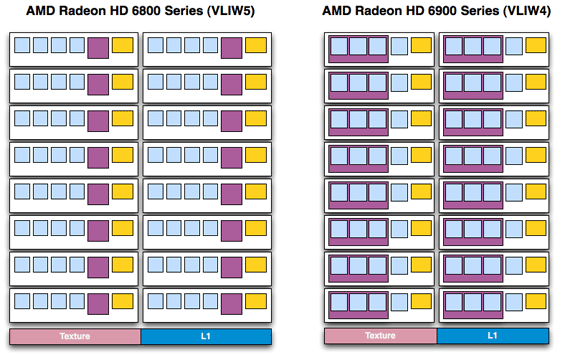AMD's Radeon HD 6970 & Radeon HD 6950: Paving The Future For AMD
by Ryan Smith on December 15, 2010 12:01 AM ESTVLIW4: Finding the Balance Between TLP, ILP, and Everything Else
To properly frame why AMD went with a VLIW4 design we’d have to first explain why AMD went with a VLIW5 design. And to do that we’d have to go back even further to the days of DirectX 9, and thus that is where we will start.
Back in the days of yore, when shading was new and pixel and vertex shaders were still separate entities, AMD (née ATI) settled on a VLIW5 design for their vertex shaders. Based on their data this was deemed the ideal configuration for a vertex shader block, as it allowed them to process a 4 component dot product (e.g. w, x, y, z) and a scalar component (e.g. lighting) at the same time.
Fast forward to 2007 and the introduction of AMD’s Radeon HD 2000 series (R600), where AMD introduced their first unified architecture for the PC. AMD went with a VLIW5 design once more, as even though the product was their first DX10 product it still made sense to build something that could optimally handle DX9 vertex shaders. This was also well before GPGPU had a significant impact on the market, as AMD had at best toyed around with the idea late in the X1K series’ lifetime (and well after R600 was started).

Now let us jump to 2008, when Cayman’s predecessors were being drawn up. GPGPU computing is still fairly new – NVIDIA is at the forefront of a market that only amounts to a few million dollars at best – and DX10 games are still relatively rare. With 2+ years to bring up a GPU, AMD has to be looking forward at where things will be in 2010. Their predictions are that GPGPU computing will finally become important, and that DX9 games will fade in importance to DX10/11 games. It’s time to reevaluate VLIW5.
This brings us to the present day and the launch of Cayman. GPGPU computing is taking off, and DX10 & DX11 alongside Windows 7 are gaining momentum while DX9 is well past its peak. AMD’s own internal database of games tells them an interesting story: the average slot utilization is 3.4 – on average a 5th streaming processor is going unused in games. VLIW5, which made so much sense for DX9 vertex shaders is now becoming too wide, while scalar and narrow workloads are increasing in number. The stage is set for a narrower Streaming Processor Unit; enter VLIW4.
As you may recall from a number of our discussions on AMD’s core architecture, AMD’s architecture is heavily invested in Instruction Level Parallelism, that is having instructions in a single thread that have no dependencies on each other that can be executed in parallel. With VLIW5 the best case scenario is that 5 instructions can be scheduled together on every SPU every clock, a scenario that rarely happens. We’ve already touched on how in games AMD is seeing an average of 3.4, which is actually pretty good but still is under 80% efficient. Ultimately extracting ILP from a workload is hard, leading to a wide delta between the best and worst case scenarios.

Meanwhile all of this is in stark contrast to Thread Level Parallelism (TLP), which looks for threads that can be run at the same time without having any interdependencies. This is where NVIDIA has focused their energies at the high-end, as GF100/GF100 are both scalar architectures that rely on TLP to achieve efficient operation.
Ultimately the realization is that AMD’s VLIW5 architecture is not the best architecture going forward. Up until now it has made sense at a high efficiency gaming-oriented design, and even today in a gaming part like the 6800 series it’s still a reasonable choice. But AMD needs a new architecture for the future, not only as something that’s going to better fit their 3.4 shader average, but something that is better designed for compute workloads. AMD’s choice is an overhauled version of their existing architecture. Overall it’s built on a solid foundation, but VLIW5 is too wide to meet their future goals.
The solution is to shrink their VLIW5 SPU to a VLIW4 SPU. Specifically, the solution is to remove the t-unit, the architecture’s 5th SP and largest SP that’s capable of both regular INT/FP operations as well as being responsible for transcendental operations. In the case of regular INT/FP operations this means an SPU is reduced from being able to process 5 operations at once to 4. While in the case of transcendentals an SPU now ties together 3 SPs to process 1 transcendental in the same period of time, representing a much more severe reduction in theoretical performance as an SPU can only process 1 transcendental + 1 INT/FP per clock as opposed to 1 transcendental + 4 INT/FP operations (or any variations).

There are a number of advantages to this change. As far as compute is concerned, the biggest advantage is that much of the space previously allocated to the t-unit can now be scrounged up to build more SIMDs. Cypress had 20 SIMDs while Cayman has 24; on average Cayman’s shader block is 10% more efficient per mm2 than Cypress’s , taking in to account the fact that Cayman’s SPs are a bit larger than Cypress’ to pick up the workload the t-unit would handle. The SIMDs are further tied to a number of attributes: the number of texture units, the number of threads that can be in flight at once, and the number of FP64 operations that can be completed per clock. The latter is particularly important for AMD’s compute efforts, as they can now retire FP64 FMA/MUL operations at 1/4th their FP32 rate, in the case of a full Cayman up to 384/clock. Technically speaking they’re no faster per SPU, but with this layout change they have more SPUs to work with, improving their performance.

Fewer SPs per SIMD = More Space For More SIMDs
There are even ancillary benefits within the individual SPUs. While the SP count changed the register file did not, leading to less pressure on each SPU’s registers as now only 4 SPs vie for register space. Even scheduling is easier as there are fewer SPs to schedule and the fact that they’re all alike means the scheduler no longer has to take into consideration the difference between the w/x/y/z units and the t-unit.
Meanwhile in terms of gaming the benefits are similar. Games that were already failing to fully utilize the VLIW5 design now have additional SIMDs to take advantage of, and as rendering is still an embarrassingly parallel operation as far as threading is concerned, it’s very easy to further divide the rendering workload in to more threads to take advantage of this change. The extra SIMDs mean that Cayman has additional texturing horsepower over Cypress, and the overall compute:texture ratio has been reduced, a beneficial situation for any games that are texture/filtering bound more than they’re compute bound.
Of course any architectural change involves tradeoffs, so it’s not a pure improvement. For gaming the tradeoff is that Cayman isn’t going to be well suited to VLIW5-style vertex shaders; generally speaking games using such shaders already run incredibly fast, but if they’re even GPU-bound in the first place they’re not going to gain much from Cayman. The other big tradeoff is when transcendental operations are paired with vector operations, as Cypress could handle both in one clock while Cayman will take two. It’s AMD’s belief that these operations are rare enough that the loss of performance in this one situation is worth it for the gain in performance everywhere else.
It’s worth noting that AMD still considers VLIW4 to be a risky/experimental design, or at least this is their rationale for going with it first on Cayman while sticking to VLIW5 elsewhere. At this point we’d imagine the real experiment to already be over, as AMD would already be well in the middle of designing Cayman’s 28nm successor, so they undoubtedly know if they’ll be using VLIW4 in the future.
Finally, the switch to a new VLIW architecture means the AMD driver team has to do some relearning. While VLIW4 is quite similar to VLIW5 it’s not by any means identical, which is both good and bad for performance purposes. The bad news is that it means many of AMD’s VLIW5-centric shader compiler tricks are no longer valid; at the start shader compiler performance is going to be worse while AMD learns how to better program a VLIW4 design. The good news is that in time they’re going to learn how to better program a VLIW4 design, meaning there’s the potential for sizable performance increases throughout the lifetime of the 6900 series. That doesn’t mean they’re guaranteed, but we certainly expect at least some improvement in shader performance as the months wear on.
On that note these VLIW changes do mean that some code is going to have to be rewritten to better deal with the reduction of VLIW width. AMD’s shader compiler goes through a number of steps to try to optimize code, but if kernels were written specifically to organize instructions to go through AMD’s shaders in a 5-wide fashion, then there’s only so much AMD’s compiler can do. Of course code doesn’t have to be written that way, but it is the best way to maximize ILP and hence shader performance.
VLIW5:
- 4 32-bit FP MAD
- Or 2 64-bit FP MUL or ADD
- Or 1 64-bit FP MAD
- Or 4 24-bit Int MUL or ADD
- Plus 1 transcendental or 1 32-bit FP MAD
VLIW4:
- 4 32-bit FP MAD/MUL/ADD
- Or 2 64-bit FP ADD
- Or 1 64-bit FP MAD/FMA/MUL
- Or 4 24-bit INT MAD/MUL/ADD
- Or 4 32-bit INT ADD/Bitwise
- Or 1 32-bit MAD/MUL
- Or 1 64-bit ADD
- Or 1 transcendental plus 1 32-bit FP MAD










168 Comments
View All Comments
anactoraaron - Wednesday, December 15, 2010 - link
I would like to thank Ryan for the article that makes me forget the "OC card in the review" debacle. Fantastic in depth review with no real slant to team green or red. Critics go elsewhere please.Hrel - Wednesday, December 15, 2010 - link
When are you guys gonna put all these cards in bench? Some of them have been out for a relatively long time now and they're still not in bench. Please put them in there.ajlueke - Wednesday, December 15, 2010 - link
I agree with most of the conclusions I have read here. If you already own a 5800 series card, there isn't really enough here to warrant an upgrade. Some improved features and slightly improved FPS in games doesn't quite give the same upgrade incentive as the 5870 did compared a 4870.There are some cool things with the 6900 and 6800 series. Looking at the performance in games, the 6970 and even the 6870 seemed to get much closer to 2X performance when placed in crossfire as compared to 5800 series cards. That is a pretty interesting development. All in all, a good upgrade if you didn't buy a card last generation. If you did, it seems the wait is on for the 28 nm version of the GPU.
Belard - Wednesday, December 15, 2010 - link
NO!The 800 cards were the HIGH end models since the 3000 series and worked well through to the 5000 series with the 5970 being the "odd one" since the "X2" made more sense like the 4850X2.
It also allows for a "x900" series if needed.
AMD needs to NOT COPY Nvidia's naming games... did they hire someone from Nvidia? Even the GeForce 580/570 still belong to the 400 series since its the same tech. SHould have been named 490 and the 475... But hey, in 12 months, Nvidia will be up to the 700 series. Hey, Google Chrome is version 8.0 and its been on the market for about 2 years! WTF?!
What was their excuse again? Oh, to not create confusion with the 5700 series? So they frack up the whole model names for a mid-range card? The 6800's should have been 6700s, simple as that. Yes, there will be some people who will accidentally downgrade.
What the new 6000 series has going for AMD is that they are somewhat cheaper and easily cost less to make than the 5000s and what Nvidia makes.
In the end, the 6000 series is the first dumb-thing AMD has done since the 2000 series, but nowhere near as bad.
MS - Wednesday, December 15, 2010 - link
In terms of effienct usage of space though AMD is doing quite well; ... should be efficientNice article so far,
Regards,
Michael
nitrousoxide - Wednesday, December 15, 2010 - link
The power connector on the left (8-pin of 6970 and 6-pin of 6950) has a corner (bottom left corner) cut down, that's because the cooler doesn't fit with the PCB design, if you install it with force the power connector would get stuck. So the delay of 6900 Series could be due to this issue, AMD needs one month to 'manually polish' all power connectors of the stock-cards in order to go with the cooler. Well, just a joke, but this surely reflects how poorly AMD organizes the whole design and manufacture process :)nitrousoxide - Wednesday, December 15, 2010 - link
you can find this out here :)hiphotos. baidu. com/coreavc/pic/item/70f48d81ffe07cf26d811957. jpg
nitrousoxide - Wednesday, December 15, 2010 - link
AMD promises that every one will get a unique 6970 or 6950, different from any other card on the planet :)GummiRaccoon - Wednesday, December 15, 2010 - link
The performance of these cards is much better with 10.12, why didn't you test it with that?Ryan Smith - Wednesday, December 15, 2010 - link
10.12 does not support the 6900 series.8.79.6.2RC2, dated December 7th, were the absolute latest drivers for the 6900 series at the time of publication.